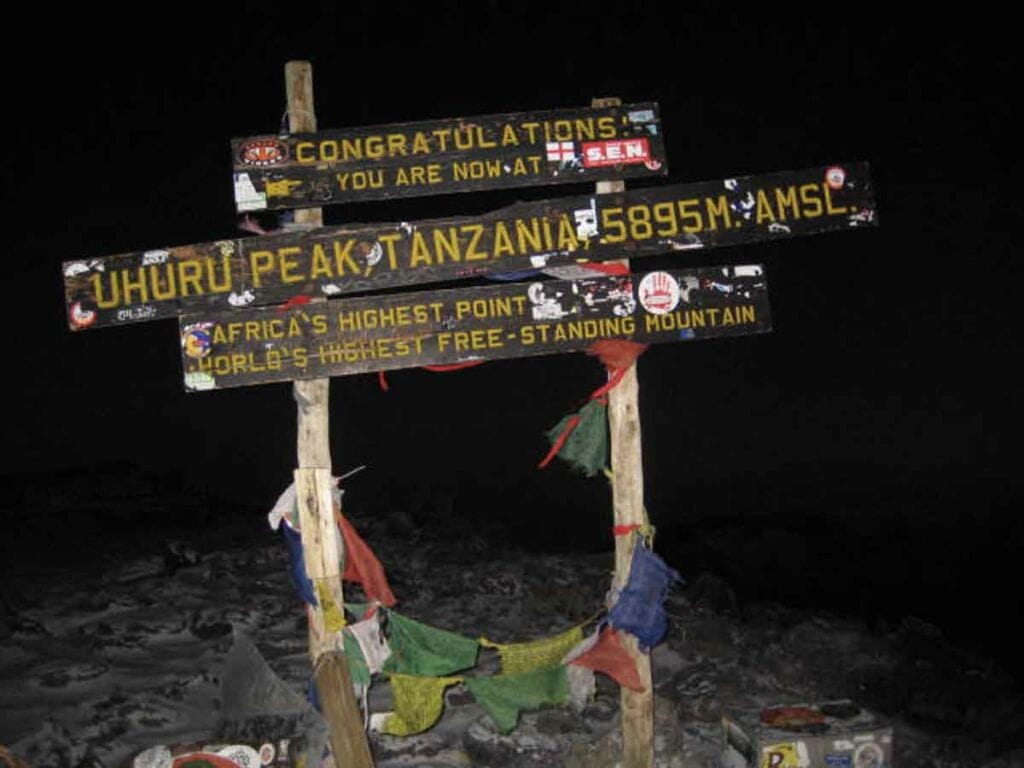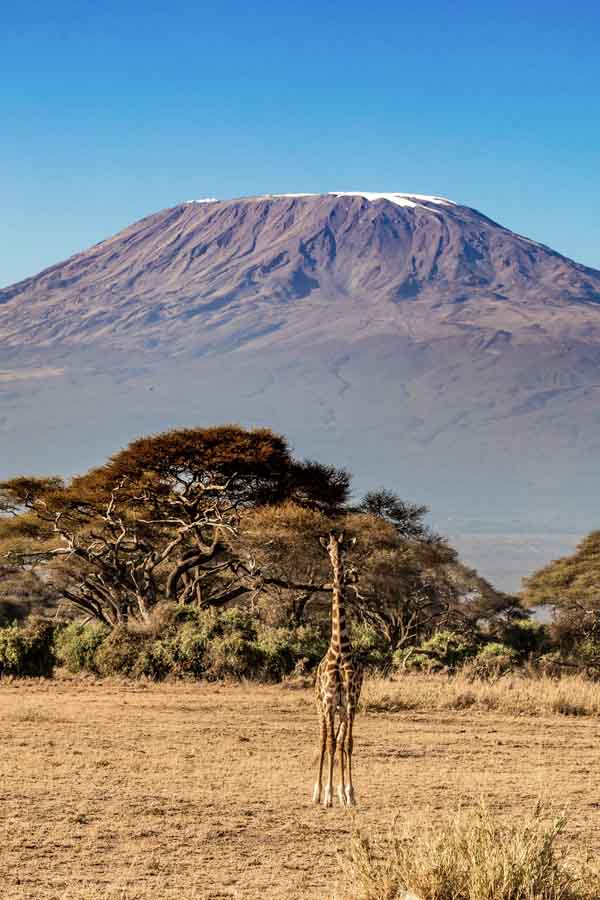Have you ever considered climbing Kilimanjaro? It’s the easiest of the Seven Summits to climb, and a true adventure of a lifetime.
It’s been a while since we wrote a mountain-related article. After our guide to climbing Mount Tai in China, and our articles about Torri del Vajolet and the Bocchette Centrali via ferrata in Trentino, here we are with a new mountain post about climbing Mount Kilimanjaro.
Our friend Silvia recently climbed Kili and wrote this article for us, sharing some important information she wished she’d know before heading to the summit of Kilimanjaro. Was there anything else you’d like to know about?
1) Where is Mount Kilimanjaro?
Mount Kilimanjaro is located in Northern Tanzania, close to the Kenyan border and just 320 km from the Equator. A Mount Kilimanjaro climb is a popular activity for people travelling to Kenya, Tanzania and other parts of East Africa.
2) How high is Mount Kilimanjaro?
Mount Kilimanjaro is Africa’s highest mountain at 5895 meters above sea level, and the highest freestanding mountain in the world since it’s not part of a mountain range, but it’s of volcanic origin.
Kili is made up of three separate cones – Kibo, Mawenzi and Shira. The highest peak is on the Kibo cone and it’s known as Uhuru, meaning freedom in Swahili, the most widely spoken language in Tanzania.
3) What is the nearest airport?
The closest airport is the Kilimanjaro International Airport (JRO). There are international flights with Turkish Airlines, KLM, Ethiopian Airlines and Qatar Airways, but most routes include a stop in Dar es Salaam before heading to Kilimanjaro. Other airlines require a connection in Arusha or Moshi airports.
4) What is the best time of the year to climb Kilimanjaro?
As we’ll explain in more detail soon, climbing Africa’s highest peak is not a walk in the park, so the least you could do is choosing the right season! Avoid climbing during the monsoon – March/June and October/December are the wettest months.
The best time to climb Kili is the dry season. There are actually two dry-weather windows – one between June and October, and another in January/February, both offering clear skies and reduced chance of rain.
My hike was in January, and the weather was quite cold but sunny almost every day, except for a couple of freak rain storms – which can always happen, thanks to climate change.
5) Are there various routes to climb Kilimanjaro?
Yes, there are 7 routes in total, all varying in terms of length and access points. These are the 4 most popular options:
-Machame Route – 6/7 days: sometimes called the ‘Whiskey route’, it’s the second most popular route to the summit of Kili, starting in the rainforest on the southern slopes and climbing in a gradual yet steady manner. This is the one I chose, and I opted for the 7-day option to maximize my chances of acclimatization – a wise choice, since only one person in my group didn’t make it to the summit.
-Marangu Route – 5/6 days: also known as the ‘Coca Cola route’, Marangu is the most popular and busiest route to the top of Kilimanjaro. It’s chosen by 30% of hikers, as it offers the benefit of staying in huts rather than camping, making it a great option for those who can only attempt the climb during the wet season. This route approaches the summit from the eastern side and it’s also the shortest route to the summit, but remember that when dealing with altitude being fast is not a good idea!
-Lemosho Route – 7/8 days: this new itinerary approaches the summit from the west, the least-visited side of the mountain. It’s slightly longer than the other routes and a little more expensive, but you’ll be rewarded with wonderful views and few other people along the way.
-Rongai Route – 6/7 days: the only route approaching Kili from the northern side, the one facing Kenya. It offers the highest chance to see large wildlife along the way, like elephants and buffaloes, and the descent follows the same itinerary as the Marangu Route. It takes
6) What is the success rate?
The success rate of Kilimanjaro climbs depends on the length of the route – basically, the quicker your climb is, the lower the success rate will be. For instance, the quickest option is the 5-day Marangu Route, which has a success rate of below 50%, climbing to 65% for the 6 day option.
The Rongai route has an 80% success rate, and for the longest options along the Lemosho and Machame route the rate climbs to 90% – worth the extra investment, if you ask me!
7) Is the climb technical?
No, ‘climbing’ Kilimanjaro actually doesn’t involve any rock climbing at all, and no technical skills are required. You’ll be hiking the entire way along paths, with guides and porters leading the way, so there’s really no danger of getting lost.
Kilimanjaro is often called ‘the highest walkable mountain in the world’ – however, it should only be attempted by people in good physical condition, and you need to be aware of the dangers of altitude.
8) What is the best way to deal with altitude sickness?
As we mentioned earlier, the summit of Kili is close to 6000 meters above sea level, and you’ll be hiking for quite some time between 4000 and 5000 meters, a danger zone for altitude sickness. You’ll likely feel the effects of altitude – headaches, dizziness, trouble sleeping and loss of appetite are common symptoms.
If the symptoms are mild, they’ll likely disappear as you acclimatize to the route. If not, you may have to take it extra easy and your guide might prevent you from reaching the summit – please do remember they’ll be doing it for your own sake and well-being, so please don’t get upset with them.
Some people take a medication called Diamox, which helps mitigate the effects of altitude. Ask your doctor or a travel clinic if you want more info about this pill and whether or not it’s ok for you.
Also remember to stay hydrated and avoid taking sleeping pills, even if you have trouble sleeping, as they affect your oxygen intake making altitude sickness worse.
9) What will you see on the way to the summit?
When climbing Kilimanjaro, remember to enjoy the journey, not just the destination! It’s a once-in-a-lifetime experience to see how the ecosystem changes as you ascend at higher altitudes.
Along the 7-day Machame Route, you spend the first day hiking through the rainforest, where you might spot monkeys and even giraffes or antelopes. The second day the rainforest is replaced by moorland, with sparse vegetation and some crazy-looking plants such as the lobelia and hot poker.
Another interesting plant you’ll probably see on day 3 is the giant groundsel or Dendrosenecio kilimanjari, endemic to Mount Kilimanjaro. These plants are approx 10 meters high, have thick stems and a crown of green leaves at the top.
The next 3 days you’ll be hiking in high-altitude rocky desert – summit day is typically day 6, and day 7 is spent descending.
10) What is the hardest day?
This is an easy one to answer! Summit day is definitely the hardest. The hike to the top starts at midnight, and personally I was running on 0 sleep. It was windy and bitterly cold, and until sunrise at 5.30 AM we were hiking in complete darkness. Most hiking groups see the sunset from a scenic vantage spot known as Stella Point, and reach the summit half an hour later.
The final part of the summit hike is also steep, on loose terrain and the altitude is fierce. However, trust me if I say that this will all be worth it when you reach the summit and stand on the roof of Africa! It’s a moment I’ll treasure for the rest of my life.
The summit is not the end of the day though, you still have a long way to go before reaching your destination – we got to our camp at 3.30 PM, after almost 15 hours hiking time!
11) What will you eat and drink?
You’ll be served three meals a day along your trek to the top of Kilimanjaro, plus an afternoon snack when you reach camp. Meals are usually simple, tasty and carb-heavy, and all companies cater to vegans and vegetarians.
For example, for breakfast you might have toast with peanut butter, porridge or cereal, accompanied by juice, coffee or tea. Some companies provide hikers with a packed lunch, and others serve a hot meal, while dinner is always a sit-down affair with dishes like pasta, rice and curry, meat and potatoes. You’ll also be offered a lot of fruit and hot drinks – remember to always stay hydrated to prevent altitude sickness!
12) How much does it cost?
The price of your Kilimanjaro climb varies depending on what route you choose, and whether or not you opt for extra days. I organized my trip to Kili with African safari company Altezza Travel, running trips every 2/3 days, that came highly recommended by a friend of mine.
The price of Kili climbing trips along the Machame Route ranges between $2000 and $2300 per person. Please don’t forget to take cash to tip your guides and porters – ask your tour company for tipping guidelines and please don’t shortchange these people who work extremely hard to support their families and ensure you have a positive experience atop Africa’s highest mountain!





